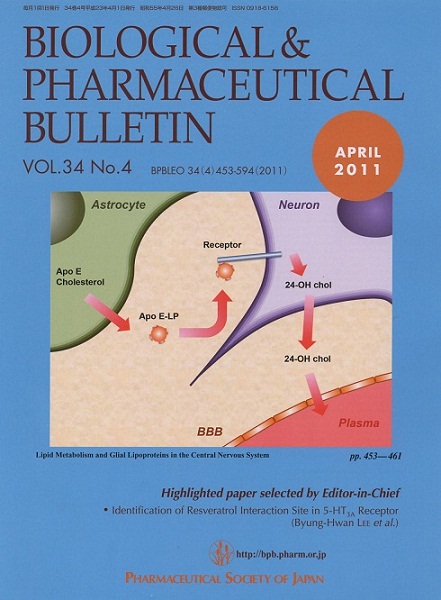Volume 34, Issue 4
Displaying 1-25 of 25 articles from this issue
- |<
- <
- 1
- >
- >|
Review
-
Article type: Review
2011Volume 34Issue 4 Pages 453-461
Published: April 01, 2011
Released on J-STAGE: April 01, 2011
Download PDF (718K)
Analytical Biochemistry
Note
-
Article type: Note
Subject area: Analytical Biochemistry
2011Volume 34Issue 4 Pages 562-566
Published: April 01, 2011
Released on J-STAGE: April 01, 2011
Download PDF (628K)
Biochemistry
Regular Articles
-
Article type: Regular Article
Subject area: Biochemistry
2011Volume 34Issue 4 Pages 462-470
Published: April 01, 2011
Released on J-STAGE: April 01, 2011
Download PDF (2160K) -
Article type: Regular Article
Subject area: Biochemistry
2011Volume 34Issue 4 Pages 471-479
Published: April 01, 2011
Released on J-STAGE: April 01, 2011
Download PDF (1724K) -
Article type: Regular Article
Subject area: Biochemistry
2011Volume 34Issue 4 Pages 480-485
Published: April 01, 2011
Released on J-STAGE: April 01, 2011
Download PDF (712K)
Note
-
Article type: Note
Subject area: Biochemistry
2011Volume 34Issue 4 Pages 567-569
Published: April 01, 2011
Released on J-STAGE: April 01, 2011
Download PDF (545K)
Molecular and Cell Biology
Regular Articles
-
Article type: Regular Article
Subject area: Molecular and Cell Biology
2011Volume 34Issue 4 Pages 486-489
Published: April 01, 2011
Released on J-STAGE: April 01, 2011
Download PDF (867K) -
Article type: Regular Article
Subject area: Molecular and Cell Biology
2011Volume 34Issue 4 Pages 490-494
Published: April 01, 2011
Released on J-STAGE: April 01, 2011
Download PDF (824K) -
Article type: Regular Article
Subject area: Molecular and Cell Biology
2011Volume 34Issue 4 Pages 495-500
Published: April 01, 2011
Released on J-STAGE: April 01, 2011
Download PDF (1046K) -
Article type: Regular Article
Subject area: Molecular and Cell Biology
2011Volume 34Issue 4 Pages 501-506
Published: April 01, 2011
Released on J-STAGE: April 01, 2011
Download PDF (1680K)
Microbiology
Note
-
Article type: Note
Subject area: Microbiology
2011Volume 34Issue 4 Pages 570-574
Published: April 01, 2011
Released on J-STAGE: April 01, 2011
Download PDF (980K)
Pharmacology
Regular Articles
-
Article type: Regular Article
Subject area: Pharmacology
2011Volume 34Issue 4 Pages 507-510
Published: April 01, 2011
Released on J-STAGE: April 01, 2011
Download PDF (506K) -
Article type: Regular Article
Subject area: Pharmacology
2011Volume 34Issue 4 Pages 511-516
Published: April 01, 2011
Released on J-STAGE: April 01, 2011
Download PDF (4128K) -
Article type: Regular Article
Subject area: Pharmacology
2011Volume 34Issue 4 Pages 517-522
Published: April 01, 2011
Released on J-STAGE: April 01, 2011
Download PDF (1579K) -
Article type: Regular Article
Subject area: Pharmacology
2011Volume 34Issue 4 Pages 523-527
Published: April 01, 2011
Released on J-STAGE: April 01, 2011
Download PDF (665K) -
Article type: Regular Article
Subject area: Pharmacology
2011Volume 34Issue 4 Pages 528-537
Published: April 01, 2011
Released on J-STAGE: April 01, 2011
Download PDF (1051K)
Note
-
Article type: Note
Subject area: Pharmacology
2011Volume 34Issue 4 Pages 575-579
Published: April 01, 2011
Released on J-STAGE: April 01, 2011
Download PDF (824K)
Medicinal Chemistry
Regular Article
-
Article type: Regular Article
Subject area: Medicinal Chemistry
2011Volume 34Issue 4 Pages 538-544
Published: April 01, 2011
Released on J-STAGE: April 01, 2011
Download PDF (703K)
Pharmacognosy
Note
-
Article type: Note
Subject area: Pharmacognosy
2011Volume 34Issue 4 Pages 580-585
Published: April 01, 2011
Released on J-STAGE: April 01, 2011
Download PDF (829K)
Biopharmacy
Regular Articles
-
Article type: Regular Article
Subject area: Biopharmacy
2011Volume 34Issue 4 Pages 545-550
Published: April 01, 2011
Released on J-STAGE: April 01, 2011
Download PDF (1284K) -
Article type: Regular Article
Subject area: Biopharmacy
2011Volume 34Issue 4 Pages 551-554
Published: April 01, 2011
Released on J-STAGE: April 01, 2011
Download PDF (2095K) -
Article type: Regular Article
Subject area: Biopharmacy
2011Volume 34Issue 4 Pages 555-561
Published: April 01, 2011
Released on J-STAGE: April 01, 2011
Download PDF (2648K)
Note
-
Article type: Note
Subject area: Biopharmacy
2011Volume 34Issue 4 Pages 586-589
Published: April 01, 2011
Released on J-STAGE: April 01, 2011
Download PDF (10657K)
Miscellaneous
Note
-
Article type: Note
Subject area: Miscellaneous
2011Volume 34Issue 4 Pages 590-593
Published: April 01, 2011
Released on J-STAGE: April 01, 2011
Download PDF (552K)
Errata
-
Article type: Errata
2011Volume 34Issue 4 Pages 594
Published: April 01, 2011
Released on J-STAGE: April 01, 2011
Download PDF (443K)
- |<
- <
- 1
- >
- >|
